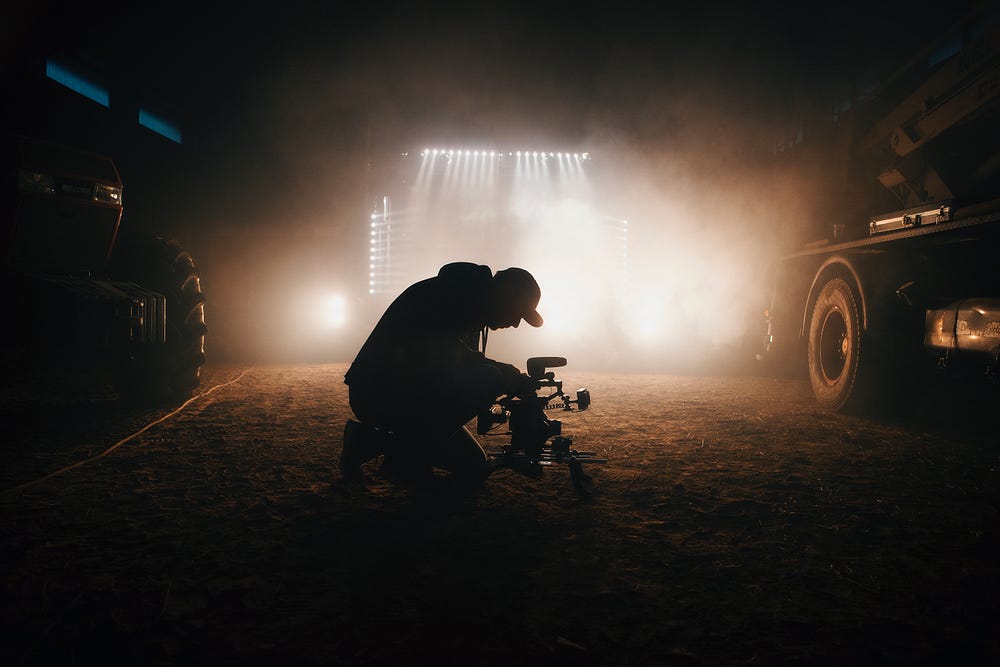I’ve spent the past half year “getting my name out there” as a video producer.
What does that look like?
Square One
You start with a cheap camera. A Rebel T6i. You begin to notice details and styles in movies and videos that were invisible to you before. You notice the cuts. You stop, rewind, and watch them again. You think about how they got that shot to look the way it looks and you wonder how many takes it took before they got it right. You wonder how many people are working behind the scenes. You discover what a Red Camera is.
You find content creators, filmmakers, and producers that you admire. You look at their portfolios, you watch their vlogs, and you consume their content. You dive deep and notice that each of them has a unique style.
You get sick of consuming and decide to start creating. The first video you make feels like a cheesy school project. So do the next 10. But you keep creating them. It’s fun. You learn about shooting, editing, cutting, and simple transitions.
Your videos aren’t good enough to display professionally, so you wonder what your still empty portfolio could become. You imagine professional videos, good lighting, crisp colors, and quality audio. You picture the projects you could do, the footage you could shoot, and the stories you could tell.
If only someone would give you a shot.

You start pitching. You ask all your friends if they need any videos. You pitch video ideas to every new person you meet. You find that everyone needs videos.
Weeks later, one person is interested in your pitch. She says:
Can you send me an email with some of your work?
Your stomach sinks. You swallow your pride and promptly follow up with some of recent cheesy school project videos.
You don’t hear back.
Later, another person is interested. She tells you she has a budget of a couple hundred dollars for the video. It’s not much, but you do it. You put a lot of effort into it. You prepare well, shoot with great attention detail, and edit for days. She doesn’t know what you’re doing and neither do you.
She likes the video! It’s better than what she could have created on her own. You make $200.
Square Two
Six months go by. You’ve upgraded to a better camera, a better microphone, a couple tripods, and a lighting setup. You’ve done more projects than you can count, some for thousands of dollars. Your portfolio resembles the one you once imagined. There are interviews, testimonials, promo videos, and all sorts of projects that look professional. Your cheesy school project videos are hidden safely on your 2TB external hard drive.
You still pitch often. People sometimes reach out to you through a mutual connection to ask for video work. Your stomach sits firmly where it belongs as you send them your Vimeo profile. They ask you for promos, testimonials, commercials, real estate videos, and the like. They say:
That Five Loaves video you did is similar to what we are looking for.
By now, you understand your camera and your editing software on a deeper level, and you see how the two dance with each other in a way they never did before. You’ve been exposed to a wider breadth of your camera’s capabilities.
You’ve connected with mentors and industry professionals. You see their process, their creations, and the resources that go into making them happen. You look at their portfolios. You consume their content. You notice their unique styles.
You see that it is possible to create so much more than the professional promo videos you once dreamed of and have now created. You imagine the films you could create, the footage you could capture, and the stories you could tell.
Square one.
This is the quandary of the aspiring filmmaker.
Like attracts like. A portfolio of nothing will attract nothing. A portfolio full of testimonial videos, promo videos, and real estate videos will attract testimonial videos, promo videos, and real estate videos.
How, then, can you create something new when you’ve boxed yourself into the style of your past?
The ideal portfolio in your head is like a carrot on a stick, extending itself beyond where you happen to be. Evolving into what you choose to be means deliberately extending that vision beyond your current capabilities.
Your portfolio follows what your vision drives you to create. The process of creating those professional-looking videos you imagined at the start is what gave you the experiences, perspectives, and tools which were the seeds of a more mature vision; one that extends yet farther beyond your current portfolio.

You’ve exposed yourself to people with unique creative styles, and you’ve explored and interacted with them on a deep level. You use this new knowledge to decide what you want to create. It’s bigger, better, more complicated, and more meaningful than what you’ve been creating. But it only exists in your mind, not in your portfolio, so nobody will believe in your ability to do it.
So you start pitching. Again. But this time you are more careful. You don’t want to add more promo videos and real estate videos to your portfolio. You don’t just take any work you can find. You’re more selective about taking on projects that allow you to express yourself creatively and fully — projects that will be the foundation of your new, more deliberately-created portfolio.
Now, when people ask you for work, it is mostly distracting. You do these jobs for income and practice, but you stop adding them to your portfolio. You begin the process of sacrificing the old to make room for the new.
Choose what you want to create. Then find and do those projects. People will want the old. To do the new, you might have to work for free or very little money again. It is not a step down; rather, it is a noble step upward.
Think and speak in terms of the projects you aspire to create, not of the ones you have created in the past. Tell potential clients your vision. At first they will mostly turn you down, just like they did before. But to keep pushing that vision is to be the driver of your own creative process, in the present and in the future. No man can creatively express himself completely if he is bending fit the will of another man.
“I don’t build in order to have clients. I have clients in order to build.”
— Ayn Rand, The Fountainhead